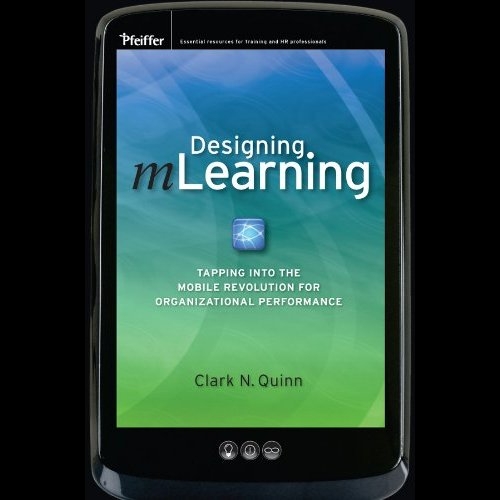- Home
- Articles
- Reviews
- About
- Archives
- Past Issues
- The eLearn Blog
Archives
| To leave a comment you must sign in. Please log in or create an ACM Account. Forgot your username or password? |
|
Create an ACM Account |

I need to start this review with a caveat: I'm a fan of Clark Quinn since his previous book, Engaging Learning, fell into my lap when I was a technology director for an eLearning vendor many moons ago. I'm also happy to call on him as a personal friend and, sometimes, a critic. So I finally get to return the favor and review his book, Designing mLearning: Tapping Into the Mobile Revolution for Organizational Performance.
I'm of the opinion that Quinn has authored the first definitive text on the subject of mobile learning. It is not (thankfully) exhaustive; rather, I believe it is the best encapsulation of the space as it is emerging. Where Engaging Learning was a book of great ideas, Designing mLearning is far more broadly accessible and useful. The material here would easily serve as a primer for any project manager in charge of developing general content for mobile platforms, regardless of its instructional intent. I would also argue that anyone looking to get started in developing a mobile application of any stripe (even outside of a "learning" context) would find much direction here.
More than delivering a tome filled with facts and figures (though there are wonderful factoids that will no doubt be useful in lots of contexts), Quinn advocates a particular design aesthetic in his approach to producing instructional and performance supporting content for mobile devices, as he writes in Chapter 3, "Our goal is letting us do what our brains do well and [provide] support for what our brains do not do well."
My favorite takeaway from Designing mLearning is the notion of the "augmented human." Quinn writes that "mLearning is about augmenteing our learning—and our performance." The idea being that mLearning is not about a full-fledged mobile-based platform to use for every learning situation; rather, mLearning is to augment, expand and/or bridge gaps in learning activities offered through many other means.
Quinn smartly takes the reader on a journey throughout the book. At the beginning, he addresses the most tactical of subjects, moving more and more operational until the value of this work presents itself in strategic discussion of how the drive for mobile technology edges both design depth and the drivers for ePerformance well past what we consider eLearning today.
This means that a broad array of performance ecosystems (content management, knowledge management, learning management) are ripe for an explosion in use if there is a mobile interface to those systems.
It's this pragmatism in Quinn's writing that draws to reread. There is a really wonderful balance of learning theory and how to, making it broadly accessible to non-technical professionals, where he very wisely writes about technology written at a level that encourages the reader to stretch only a little bit.
Aaron is the Chief Learning Officer of his consultancy, Problem Solutions. In this capacity, Aaron is the Community Manager for Advanced Distributed Learning (ADL), an applied research and development initiative through the U.S. Department of Defense, innovating a next generation of advanced, broad application learning technologies. He blogs at aaronsilvers.com and can be found on Twitter as @aaronesilvers.
|
To leave a comment you must sign in. |
|
Create an ACM Account. |
Wed, 30 Nov 2011
Karla,Post by Aaron Silvers
Thank you so much for such a nice comment. I've not read The Mobile Academy yet. What's one change you've noticed about how you're thinking about mobile, since you've started reading it?
Tue, 29 Nov 2011
What a great review. I am really looking forward to reading this book. I am about halfway through his newest book, The Mobile Academy. So far, it has given me some great ideas.Post by Karla Kmetz